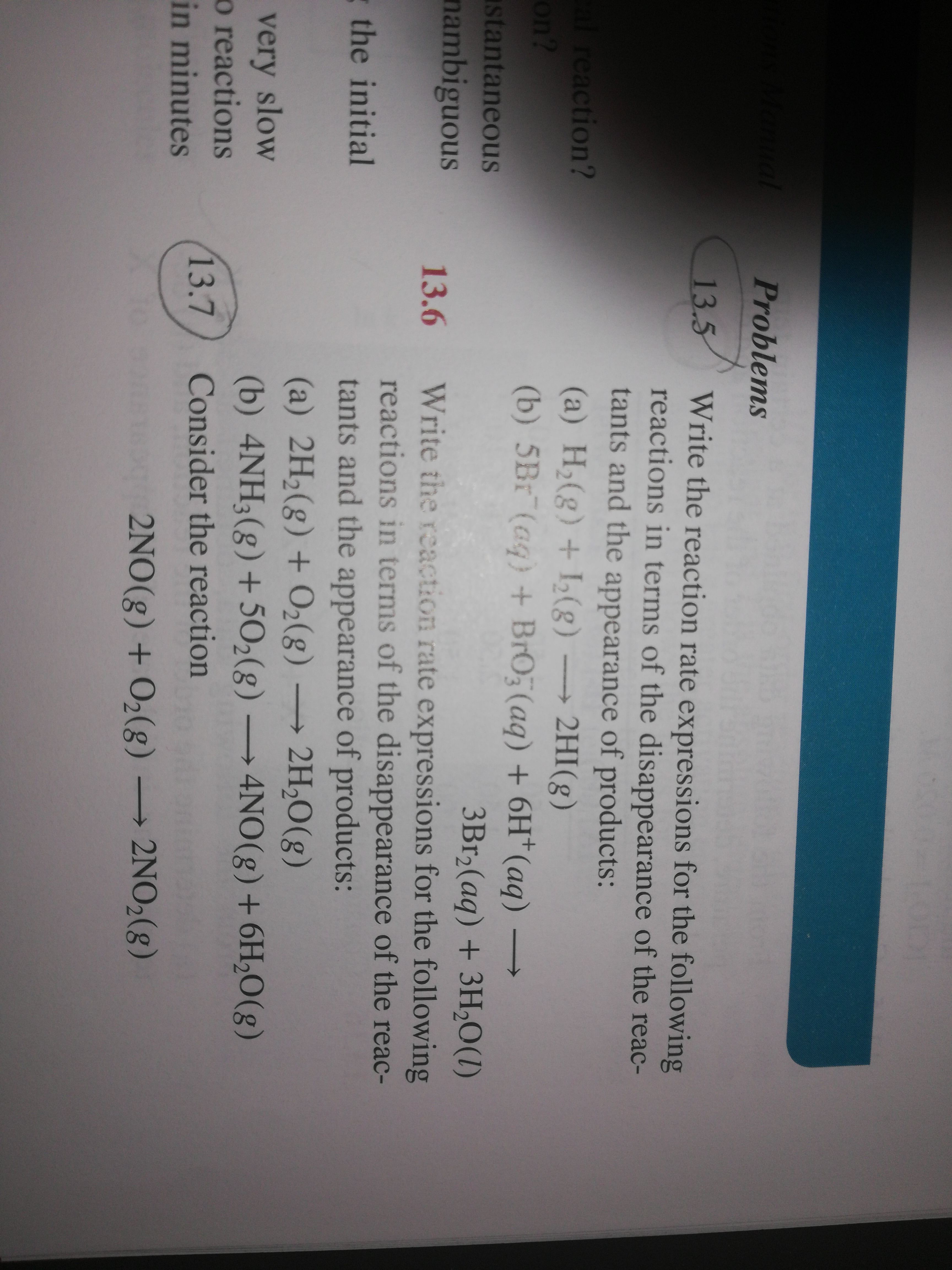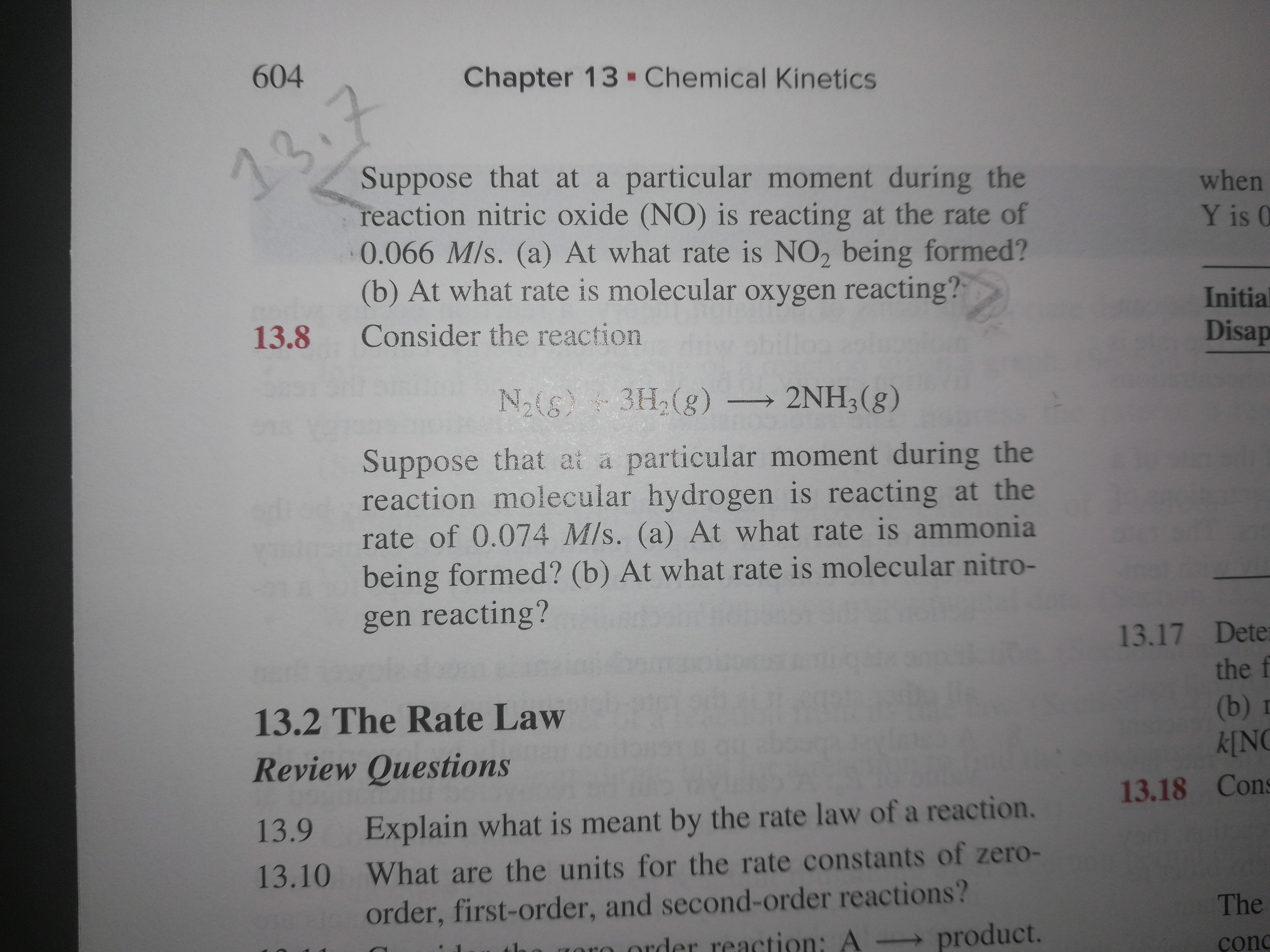Mannal Problems 13.5 Write the reaction rate expressions for the following reactions in terms of the disappearance of the reac- tants and the appearance of products: al reaction? on? (a) H2(g) + ,(8) → 2HI(g) (b) 5Br (ag) + BrO5 (aq) + 6H*(aq) → stantaneous ЗBr, (aq) + 3Н,0() nambiguous Write the reaction rate expressions for the following reactions in terms of the disappearance of the reac- tants and the appearance of products: 2H2O(g) 13.6 : the initial (a) 2H2(g) + O2(g) very slow o reactions (b) 4NH3(g)+ 502(g) →4NO(g) +6H,O(g) 13.7 Consider the reaction in minutes 2NO(g) + O2(g) 2NO2(8) 604 Chapter 13 - Chemical Kinetics 13.7 Suppose that at a particular moment during the reaction nitric oxide (NO) is reacting at the rate of 0.066 M/s. (a) At what rate is NO, being formed? (b) At what rate is molecular oxygen reacting? when Y is 0 Initial 13.8 Consider the reaction Disap N2(6)3H,(g) → 2NH3(g) Suppose that at a particular moment during the reaction molecular hydrogen is reacting at the rate of 0.074 M/s. (a) At what rate is ammonia being formed? (b) At what rate is molecular nitro- gen reacting? 13.17 Dete the f 13.2 The Rate Law (b) г k[NC Review Questions 13.18 Cons Explain what is meant by the rate law of a reaction. 13.9 13.10 What are the units for the rate constants of zero- order, first-order, and second-order reactions? - product. The tha goro order reaction: A çonc
Mannal Problems 13.5 Write the reaction rate expressions for the following reactions in terms of the disappearance of the reac- tants and the appearance of products: al reaction? on? (a) H2(g) + ,(8) → 2HI(g) (b) 5Br (ag) + BrO5 (aq) + 6H*(aq) → stantaneous ЗBr, (aq) + 3Н,0() nambiguous Write the reaction rate expressions for the following reactions in terms of the disappearance of the reac- tants and the appearance of products: 2H2O(g) 13.6 : the initial (a) 2H2(g) + O2(g) very slow o reactions (b) 4NH3(g)+ 502(g) →4NO(g) +6H,O(g) 13.7 Consider the reaction in minutes 2NO(g) + O2(g) 2NO2(8) 604 Chapter 13 - Chemical Kinetics 13.7 Suppose that at a particular moment during the reaction nitric oxide (NO) is reacting at the rate of 0.066 M/s. (a) At what rate is NO, being formed? (b) At what rate is molecular oxygen reacting? when Y is 0 Initial 13.8 Consider the reaction Disap N2(6)3H,(g) → 2NH3(g) Suppose that at a particular moment during the reaction molecular hydrogen is reacting at the rate of 0.074 M/s. (a) At what rate is ammonia being formed? (b) At what rate is molecular nitro- gen reacting? 13.17 Dete the f 13.2 The Rate Law (b) г k[NC Review Questions 13.18 Cons Explain what is meant by the rate law of a reaction. 13.9 13.10 What are the units for the rate constants of zero- order, first-order, and second-order reactions? - product. The tha goro order reaction: A çonc
Chemistry: Principles and Reactions
8th Edition
ISBN:9781305079373
Author:William L. Masterton, Cecile N. Hurley
Publisher:William L. Masterton, Cecile N. Hurley
Chapter11: Rate Of Reaction
Section: Chapter Questions
Problem 28QAP: Diethylhydrazine reacts with iodine according to the following equation: Â...
Related questions
Question
13.7

Transcribed Image Text:Mannal
Problems
13.5
Write the reaction rate expressions for the following
reactions in terms of the disappearance of the reac-
tants and the appearance of products:
al reaction?
on?
(a) H2(g) + ,(8) → 2HI(g)
(b) 5Br (ag) + BrO5 (aq) + 6H*(aq) →
stantaneous
ЗBr, (aq) + 3Н,0()
nambiguous
Write the reaction rate expressions for the following
reactions in terms of the disappearance of the reac-
tants and the appearance of products:
2H2O(g)
13.6
: the initial
(a) 2H2(g) + O2(g)
very slow
o reactions
(b) 4NH3(g)+ 502(g) →4NO(g) +6H,O(g)
13.7
Consider the reaction
in minutes
2NO(g) + O2(g)
2NO2(8)

Transcribed Image Text:604
Chapter 13 - Chemical Kinetics
13.7
Suppose that at a particular moment during the
reaction nitric oxide (NO) is reacting at the rate of
0.066 M/s. (a) At what rate is NO, being formed?
(b) At what rate is molecular oxygen reacting?
when
Y is 0
Initial
13.8
Consider the reaction
Disap
N2(6)3H,(g) → 2NH3(g)
Suppose that at a particular moment during the
reaction molecular hydrogen is reacting at the
rate of 0.074 M/s. (a) At what rate is ammonia
being formed? (b) At what rate is molecular nitro-
gen reacting?
13.17 Dete
the f
13.2 The Rate Law
(b) г
k[NC
Review Questions
13.18 Cons
Explain what is meant by the rate law of a reaction.
13.9
13.10 What are the units for the rate constants of zero-
order, first-order, and second-order reactions?
- product.
The
tha goro order reaction: A
çonc
Expert Solution
This question has been solved!
Explore an expertly crafted, step-by-step solution for a thorough understanding of key concepts.
This is a popular solution!
Trending now
This is a popular solution!
Step by step
Solved in 8 steps with 6 images

Knowledge Booster
Learn more about
Need a deep-dive on the concept behind this application? Look no further. Learn more about this topic, chemistry and related others by exploring similar questions and additional content below.Recommended textbooks for you

Chemistry: Principles and Reactions
Chemistry
ISBN:
9781305079373
Author:
William L. Masterton, Cecile N. Hurley
Publisher:
Cengage Learning

Chemistry: The Molecular Science
Chemistry
ISBN:
9781285199047
Author:
John W. Moore, Conrad L. Stanitski
Publisher:
Cengage Learning

Chemistry for Engineering Students
Chemistry
ISBN:
9781337398909
Author:
Lawrence S. Brown, Tom Holme
Publisher:
Cengage Learning

Chemistry: Principles and Reactions
Chemistry
ISBN:
9781305079373
Author:
William L. Masterton, Cecile N. Hurley
Publisher:
Cengage Learning

Chemistry: The Molecular Science
Chemistry
ISBN:
9781285199047
Author:
John W. Moore, Conrad L. Stanitski
Publisher:
Cengage Learning

Chemistry for Engineering Students
Chemistry
ISBN:
9781337398909
Author:
Lawrence S. Brown, Tom Holme
Publisher:
Cengage Learning

Introduction to General, Organic and Biochemistry
Chemistry
ISBN:
9781285869759
Author:
Frederick A. Bettelheim, William H. Brown, Mary K. Campbell, Shawn O. Farrell, Omar Torres
Publisher:
Cengage Learning

Chemistry by OpenStax (2015-05-04)
Chemistry
ISBN:
9781938168390
Author:
Klaus Theopold, Richard H Langley, Paul Flowers, William R. Robinson, Mark Blaser
Publisher:
OpenStax

Chemistry: An Atoms First Approach
Chemistry
ISBN:
9781305079243
Author:
Steven S. Zumdahl, Susan A. Zumdahl
Publisher:
Cengage Learning